
The Cyperaceae are a family of graminoid (grass-like), monocotyledonous flowering plants known as sedges. The family is large, with some 5,500 known species described in about 90 genera, the largest being the "true sedges" genus Carex with over 2,000 species.
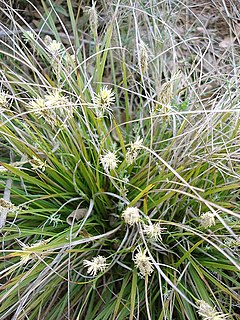
Carex is a vast genus of more than 2,000 species of grass-like plants in the family Cyperaceae, commonly known as sedges. Other members of the family Cyperaceae are also called sedges, however those of genus Carex may be called true sedges, and it is the most species-rich genus in the family. The study of Carex is known as caricology.
Swintonia is a genus of plants in the family Anacardiaceae.

Carex lasiocarpa is a broadly distributed species of wetland sedge sometimes known as woollyfruit sedge or slender sedge. It is considered a species of Least Concern by the IUCN Red List due to its extensive range with many stable populations.
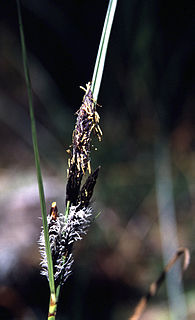
Carex obnupta is a species of sedge known by the common name slough sedge. It is native to western North America from British Columbia to California where it grows abundantly in wet, often saline habitat such as wetlands. The plant produces upright, angled stems approaching 1.2 meters in maximum height, growing in beds or colonies from rhizome networks. The inflorescence is a cluster of flower spikes accompanied by a long leaflike bract. The pistillate spikes and sometimes the staminate spikes dangle on peduncles. The fruit is coated by a hard, tough, shiny perigynium which is generally dark in color.

Carex vesicaria is an essentially Holarctic species of sedge known as bladder sedge, inflated sedge, and blister sedge. It has been used to insulate footwear in Norway and among the Sami people, and for basketry in North America.

Eucalyptus agglomerata, commonly known as blue-leaved stringybark, is a tree endemic to eastern Australia. It has persistent, stringy bark, green or greyish leaves with a bluish sheen, flower buds in groups of eleven to fifteen, white to cream-coloured flowers and crowded, flattened hemispherical fruit.

Carex panicea, commonly known as carnation sedge, is a plant species in the sedge family, Cyperaceae. It is known as grass-like sedge and can be found in Northern and Western Europe, and also in north-eastern North America. The plant produces fruits which are 3–4 millimetres (0.12–0.16 in) long, are egg shaped and spiked. Both male and female species leaves are pale blue on both sides.
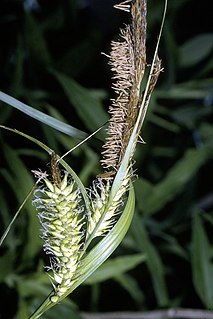
Carex lacustris, known as lake sedge, is a tufted grass-like perennial of the sedge family (Cyperaceae), native to southern Canada and the northern United States. C. lacustris us an herbaceous surface-piercing plant that grows in water up to 50 cm (1.6 ft) deep, and grows 50–150 cm (1.6–4.9 ft) tall. It grows well in marshes and swampy woods of the boreal forest, along river and lake shores, in ditches, marshes, swamps, and other wetland habitat. It grows on muck, sedge peat, wet sand or silt, in filtered or full sunlight.
Carex lemmonii, or Lemmon's sedge, is a plant in the sedge family, and is endemic to California. Carex albida is now considered a synonym, but was previously thought to be a separate species; such plants have the common name white sedge.

Phlogacanthus is a genus of flowering plants in the family Acanthaceae and tribe Andrographideae. Its distribution includes India through to Indo-China, southern China and Sulawesi.
Utricularia capillacea is a species of carnivorous plant from the Lentibulariaceae family, Lamiales order, described by Carl Ludwig Willdenow. According to the Catalogue of Life Utricularia capillacea does not have known subspecies.

Illigera is a genus of flowering plants in the family Hernandiaceae, found tropical regions of Africa and Asia.

Carex davalliana, or Davall's sedge, is a species of sedge found in inland wetlands across continental Europe. It is dioecious, with male and female flowers on separate plants.
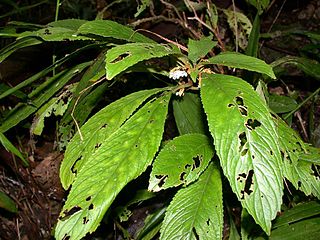
Rhynchotechum is a genus of plants in the family Gesneriaceae, subfamily Didymocarpoideae. Species distribution records are mostly from India, Sri Lanka, China through to southern Japan, Indo-China and Malesia through to New Guinea.
Carex haematorrhyncha is a species of plant in the family Cyperaceae first described by Jisaburo Ohwi and Tetsuo Michael Koyama. No subspecies are listed in the Catalogue of Life.

Carex baldensis is a species of sedge. Its native range is the Alps.
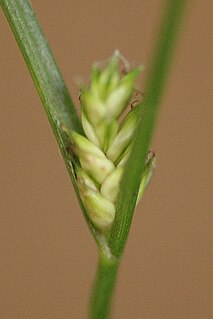
Carex remota, the remote sedge, is a species in the genus Carex, native to Europe, the Atlas Mountains in Africa, and western Asia. It is a riparian forest specialist. It is known as one of the most frequently hybridizing species of Carex, forming hybrids with C. appropinquata, C. arenaria, C. brizoides, C. canescens, C. divulsa, C. echinata, C. elongata, C. otrubae, C. ovalis, C. paniculata, and C. spicata.













